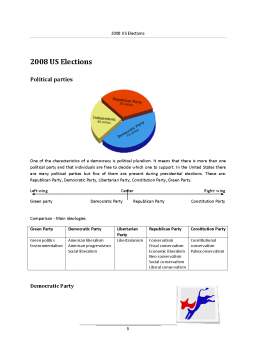Cuprins
- POLITICS OF THE UNITED STATES OF AMERICA 1
- GENERAL FACTS ABOUT THE ELECTIONS 2
- LEVELS OF ELECTION 3
- FEDERAL ELECTIONS 3
- STATE ELECTIONS 3
- LOCAL ELECTIONS 3
- ELIGIBILITY 3
- BEING A MEMBER OF A POLITICAL PARTY 4
- VOTER REGISTRATION 4
- 2008 US ELECTIONS 5
- POLITICAL PARTIES 5
- DEMOCRATIC PARTY 6
- REPUBLICAN PARTY 6
- THE NOMINATION PROCESS 7
- CANDIDATES 8
- ON THE DEMOCRATIC SIDE 8
- HILLARY CLINTON EROARE! MARCAJ ÎN DOCUMENT NEDEFINIT.
- BARACK OBAMA 8
- ON THE REPUBLICAN SIDE 9
- JOHN MCCAIN 9
- COMPARISON – TOP ISSUES DISCUSSED 9
- IRAQ 9
- IMMIGRATION 10
- INTERNATIONAL RELATIONS 10
- EDUCATION 10
- THE ECONOMY 11
- HEALTH CARE 11
- WHO WILL WIN? 12
- DEMOCRATIC RACE 12
- THE REPUBLICANS HAVE DECIDED 12
- CONCLUSION 13
Extras din proiect
Politics of the United States of America
The United States of America is a constitutional federal republic. The United States is the third largest country by total area and by population. It has 9.83 million km² and more than 300 million people. It is structured in 50 states and a federal district. It is considered the oldest surviving federation and one of the most powerful democracies. Abraham Lincoln said that “Democracy is the government of the people, by the people, for the people.”
In order to have a real democracy the powers in the state must control one another – the principal of the separation of powers. These are the executive, legislative and judicial power. The executive branch is headed by the President and is independent of the legislature. The President of the Unites States is head of state and head of government. In the American system, citizens are usually subject to three levels of government, federal, state, and local. Legislative power is vested in the two chambers of Congress, the Senate and the House of Representatives. Judicial power is exercised by the judicial branch, composed of the Supreme Court and lower federal courts. The judiciary's function is to interpret the United States Constitution as well as the federal laws and regulations. This includes resolving disputes between the executive and legislative branches.
General facts about the elections
The United States has a federal government, with elected officials at federal, state and local level. On a national level, the President, is elected indirectly by the people, through electors of an Electoral College . All members of the Congress are directly elected. There are many elected offices at state level, each state having at least an elective governor and legislature. There are also elected offices at local level, in counties and cities.
There are two basic types of elections – primary and general.
A primary election is a nominating election. In federal elections, candidates are chosen not by party officials, but by primary elections and caucuses . There are several candidates for each party and the citizens decide who will represent the party in the general elections. Victory in a primary results in a candidate being nominated by a political party for the general election. In presidential elections, after primaries, each party holds a national convention to formally select the presidential nominee. The nominee is the candidate who has the support of the most convention delegates (this is decided during the primaries). He then chooses a running mate to be the party’s candidate for vice president.
A general election is an election held to choose among candidates nominated in the primary election. It is the final choice among various candidates nominated but this time it is a confrontation between political parties and not inside a party. It is an indirect election for president because it all comes down to the Electoral College. The political parties nominate electors at state party conventions or at the party’s general committee and so the Electoral College is formed. These citizens will cast votes for the president on behalf of al the voters. The voters in each state, by casting votes for president and vice president, choose the electors on the day of the general election. The Electoral College, not the popular vote, elects the president. There are a total of 538 votes in the Electoral College. In order to become president a candidate must win with a simple majority: 270 votes. If no presidential candidate wins a majority of electoral votes, then the presidential election will be decided by the House of Representatives (12th Amendment of the Constitution). The House selects the president by majority vote, choosing from the three candidates who received the greatest number of electoral votes. Each state has one vote.
Levels of election
In the United States of America there are different types of elections. They are held in order to organize the administration at different levels in the state, from local to federal. There are local elections, state and federal elections.
Federal elections
Presidential elections
The President and the Vice President are elected together in a Presidential election. The election is indirect, the winner being determined by votes cast by electors of the United States Electoral College.
Congressional elections
Senate elections - The Senate has 100 members, elected for a six year term in dual-seat constituencies (two from each state) with one-third being renewed every two years.
House elections - The House of Representatives has 435 members, elected for a two year term in single-seat constituencies.
Preview document
Conținut arhivă zip
- US Elections.doc
- US elections.ppt























